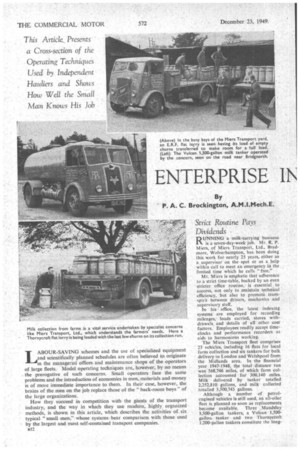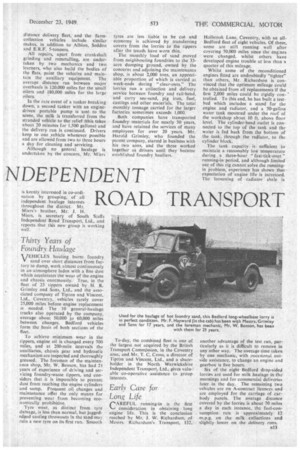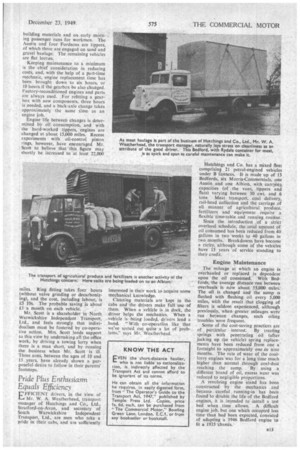ENTERPRISE IN NDEPENDENT ROAD TRANSPORT
Page 46

Page 47

Page 48

Page 49

If you've noticed an error in this article please click here to report it so we can fix it.
By P. A. C. Brockington, A.M.I.Mech.E.
/4ABOUR-SAVING schemes and the use of specialized equipment and scientifically planned schedules are often believed to originate in the managerial offices and maintenance shops of the operators of large fleets. Model operating techniques are, however, by no means
the prerogative of such concerns. Small operators face the same problems and the introduction of economies in men, materials and money is of more immediate importance to them. In their case, however, the brains of the men on the job replace those of the "back-room boys" of the large organizations.
How they succeed in competition with the giants of the transport industry, and the way in which they use modern, highly organized methods, is shown in this article, which describes the activities of six typical "small men," whose systems bear comparison with those used by the largest and most self-contained transport companies. 612 Strict Routine Pays Dividends DUNNII■lC; a milk-carrying business
is a seven-day-week job. Mr. R. P. Miers, of Miers Transport, Ltd., Bradmore, Wolverhampton, has been doing this work for nearly 25 years, either as a supervisor on the spot or as a help within call to meet an emergency in the limited time which he calls "free."
Mr. Miers is emphatic that adherence to a strict time-table, backed by an even stricter office routine, is essential to success, not only to maintain technical efficiency, but also to promote teamspirit betweendrivers, mechanics and supervisory staff.
In his office, the latest indexing systems are employed for recording mileages, loads carried, stores withdrawals and details of all other cost factors. Employees readily accept timeclocks and performance recorders as aids to harmonious working.
The Miers Transport fleet comprises 23 vehicles, including 16 flats for local farm collection and six tankers for bulk delivery to London and Welshpool from the Midlands area. In the financial year 1947-1948, the total distance run was 568,746 miles, of which farm collection accounted for 300,140 mites. Milk delivered by tanker totalled 2,252,810 gallons, and milk collected totalled 3,500,743 gallons.
Although a number of petrolcngined vehicles is still used, an all-oiler fleet is planned as soon as replacements become available. Three ,Maudslay I,500-gallon tankers, a Vulcan 1,500gallon tanker and two Tharnycioft 1.200-gallon tankers constitute the long distance delivery fleet, and the farmcollection vehicles include similar makes, in addition to Albion, Seddon and E.R.F. 5-tonners.
All repairs. apart from crankshaft grinding and remetalling, are Undertaken by two mechanics and two learners, who also build the bodies of the flats, paint the vehicles and maintain the auxiliary equipment. The average distance run between major overhauls is 120,000 miles for the small oilers and 180,000 miles for the large
In the rare event of a tanker breaking down., a second tanker with an enginedriven portable pump is sent to the scene, the milk is transferred from the stranded vehicle to the relief (this takes about 20 minutes for 1.500 gallons) and the delivery, run is continued. Drivers keep to one vehicle whenever possible and are allowed from two to three hours a day for cleaning and servicing.
Although no general haulage is undertaken by the concern, Mr. Miers is keenly interested in co-ordination by grouping, of all independent haulage interests throughout the district. Mr. Miers's brother, Mr. J. H. Miers, is secretary of South Staffs Independent Road Transport, Ltd., and reports that thds new group is working well.
Thirty Years of Foundry Haulage VIEHICLES hauling burnt foundry V sand over short distances from factory to damp, work almost continuously in an atmosphere laden with a fine dust which accelerates the wear of the engine and chassis enormously. True, in the fleet of 23 tippers owned by H. R. Grimley and Sons, Ltd., and the associated company of Tipton and Vincent, Ltd.. Coventry, vehicles rarely cover 25,000 miles before engine replacement is needed. The 10 general-haulage trucks also operated by the company, average about 50.000 to 60,000 miles between changes. Bedford vehicles form the basis of both sections of the fleet.
To achieve minimum wear in the tippers, engine oil is changed every 700 miles, and at 200-mile intervals the auxiliaries, chassis gear and hydraulic mechanism are inspected and thoroughly greased. The foreman of the maintenance shop, Mr. W. Benson, has had 21 years of experience of driving and servicing foundry-waste tippers, and considers that it is impossible to prevent dust from reaching the engine cylinders and sump. Frequent oil changes and maintenance offer the only means for preventing wear from becoming economically prohibitive.
Tyre wear, as distinct from tyre damage, is less than normal, but jagged. edged casting throwouts in the sand may ruin a new tyre on its first run. Smooth tyres are less liable to be cut and economy is achieved by transferring covers from the lorries to the tippers after the treads have worn thin.
The monthly load of sand moved from neighbouring foundries to the 33acre dumping ground, owned by the concerns and adjoining the maintenance shop, is about 2,000 tons, an appreciable proportion of which is carried at week-ends during "clear-outs." The lorries run a collection and delivery service between foundry and rail-head, and carry sea-sand, pig iron, fuel. castings and other materials. The total monthly tonnage carried for the larger factories sometimes exceeds 1,000.
Both companies have transported foundry materials for nearly 30 years, and have retained the services of many employees for over 20 years. Mr. Harold Grimley, who founded the -parent company, started in business with his two sons, and the three worked together as drivers until they became established foundry hauliers.
To-day, the combined fleet is one of the largest not acquired by the British Transport Commission, in the Coventry area, and Mr. T. C. Cross, a director of Tipton and Vincent, Ltd., and a shareholder in the North Warwickshire Independent Transport, Ltd., gives valuable co-operative assistance to group interests,
Earl., Care for Long Life cAREFUL running-in is the first
consideration in obtaining long engine life. This is the conclusion reached by Mr. J. W. Richardson, of Messrs. Richardson's Transport, 132, Holbrook Lane, Coventry, with an allBedford fleet of eight vehicles. Of these, some are still running well after covering 70,000 miles since the engines were changed, whilst others have developed engine trouble at less than a quarter of this mileage.
Whilst some of the reconditioned engines fitted are undoubtedly "tighter" than others, Mr. Richardson is convinced that the optimum mileage could be obtained from all replacements if the first 2,000 miles could be rigidly controlled. To this end, he has built a testbed which includes a stand for the engine and radiator, and a 50-gallon water tank motinted under the roof of the workshop about 10 ft. above floor level. The cylinder-head outlet is connected to the top of the tank and the water is fed back from the bottom of the tank, through the radiator, to the cylinder block.
The tank capacity is sufficient to maintain a reasonably low temperature during a three-hour "fast-tick-over" running-in period, and although limited use of this rig cannot solve the runningin problem, experience has shown thatexpectation of engine life is increased. The loosening of radiator shale is
another advantage of the test run, particularly as it is difficult to remove in any other way. The average time taken by one mechanic, with occasional outside assistance, to change an engine and gearbox is five hours.
Six of the eight Bedfcrd drop-sided lorries are used for milk haulage in the mornings and for commercial deliveriea later in the day. The remaining two vehicles are on A-contract licences and are employed for the carriage of carbody panels. The average distance covered by the lorries is about 70 miles a day in each instance, the fuel-consumption rate is approximately 12 m.p.g. on the milk collections and slightly lower on the delivery runs. Mr. Richardson is secretary of the newly formed North Warwickshire Independent Transport, Ltd., and claims. that the group has already shown promising results.
wo,000 Mlles Between Major. Overhauls AT variance with common practice, the engines of the 12 Bedfords comprising the fleet operated by Messrs. Chalmers Transport, Henley-in-Arden, Warwickshire, are completely , overhauled on the premises. After a vehicle has covered 357000 miles, the engine is
removed from the chassis and the pistons are fitted • with Wellworthy Simplex rings. A major overhaul, is not generally necessary until at least A5,000 miles (often more than 100,000 miles) have been run.
The consistently low rates of wear achieved are attributed in part to the use of Filtrate graphite additive in the oil d,uring the first 2,000 miles when an engine is.new or after an overhaul. The oil is changed. at 500 miles, at 2,000 miles and thereafter at 3,000-mile intervals.
With the exception of cylinder siceving, crankshaft grihding and reconditioning the electrical components, every job in a major overhaul is performed by the two mechanics in the workshops. features of which are the ample window area and th:. provision of conveniently placed strip-lighting.
Rocker re-bushing, waterand petrol-pump overhaul and repainting are also carried out. A jig for checking connecting-rod alignment is regarded as an essential item of worksho-p repair equipment.
One overhauled engine is kept in stock so that when a vehicle is docked the mechanics have more time to concentrate on repairs to . the chassis. The latter is stripped and B14 &scaled with .a welding-plant . attachment to facilitate iniPeetion, repair and final painting. • , Normal practice is to renew the shackles, steering johns and hub oilseals. "'which are reassembled with graphite grease. Transmission components are overhauled as required. Maintaining a large stock of spares has been amply justified by the consequent saving in overall repair costs.
The fleet contains one further vehicle, a, Maudslay Mogul Mark II, which is employed on milk transport and haulage of agricultural produce, fertilizers and feeding-stuffs.
The vehicles cover about.400 miles a week each, and the average petrol-consumption rate of the Bedfords is 12 m.p.g. Two mechanical loaders, a Wolseley and a Thwaites, have been prov-d invaluable as time-saving appliances.
Modifications and practices which have been recently introduced include rebuilding the bodies with angle-iron runners on the wooden bearers, replacing damaged wings with the Dunlop rubber type, and fitting windscreen heaters in the drivers' cabs for winter Ilse.
One of the three partners in. the firm, Mr. H. Chalmers, reinembers the fleet 26 years ,ago, when it comprised one Model 1' Ford, which was purchased to supplement a horse-and-cart fleet in a milk delivery round. Mr. Chalmers is a shareholder in South Warwickshire Independent Road Transport, Ltd.
Ready Spares Cut Costs
" IF you want to avoid unprofitable days, never exceed the vehicle's loading capacity, and always keep a spare engine, ' gearbox and back axle in stocI," is the advice of Mr. L. C. Scott, Scotchill. Keresley, Coventry. In 15 years of haulage experience, this operator has found that he can keep his vehicles almost continuously on the building materials and on early morning passenger runs for workmen. The Austin and four Fordsons are tippers, of which three are engaged on sand and gravel haulage. The remaining vehicles are flat lorries.
Keeping maintenance to a minimum is the chief consideration in reducing costs, and, with the help of a part-time mechanic, engine replacement time has been brought down to six hours, or 10 hours if the gearbox be also changed. Factory-reconditioned engines and parts. are always used. Fr refitting a gearbox with new components, three hours is needed, and a back-axle change takes approximately the same time as an engine job.
Engine life between changes is determined list oil consumption, and with the • hard-worked -tippers, engines are changed at about 15,000 miles. Recent experiments with oil-control piston rings, however, have encouraged Mr. Scott to believe that 'this. figure may shortly be increased to at least 22,000
miles. Ring _fitting takes four hours (without valve grinding or decarbonizing), and the cost, including labour, is 15 10s. The probable saving is about fl a month on each vehicle: .
Mr. Scott is a shareholder in --North Warwickshire Independent Transport, Ltd., and feels strongly that individualism must be fostered by co-operative action. Mrs. Scott lends support to this view by undertaking all the office work, by driving a towing lorry when there is a man short, and by running the business when Mr. Scott is ill. Three sons, between the ages of 10 and 15 years, have already shown a purposeful desire to follow in their parents' footsteps.
Pride Plus Enthusiasm Equals Efficiency
EFFICIENT drivers, in the view of Mr. W. A. Weatherhead, transport manager of Hutchings and Co., Ltd.. Stratford-on-Avon, and secretary of South Warwickshire Independent Transport. Ltd.,• are men who take a pride in their cabs, and are sufficiently
interested in their work to acquire some mechanical knowledge.
Cleaning materials are kept in the cabs and the drivers make full use of them. When a vehicle is in dock, the driver helps the mechanics. When a —vehicle is being loaded, drivers lend a hand. "With co-operation like that we've sorted out quite a lot of problems," says Mr. Weatherhead.
• Hutchings and Co. has a mixed fleet comprising 21 petrol-engined vehicles under B licences. It is made up of 13 Bedfords, six Morris-Commercials, one
• Austin and one Albion, with carrying capacities (of the vans, tippers and flats) varying between 30 cwt. and 6 tons. Meat transport, coal delivery, rail-head collection and the carriage of all manner of agricultural produce, fertilizers and equipment require a flexible time-table and running routine.
Since the introduction of a strict overhaul schedule, the total amount of oil consumed has been reduced from 40 gallons in two 'weeks to 40 gallons in two months. Breakdowns have become a rarity, although some of the vehicles have 15 years of service standing to their credit.
Engine Maintenance
The mileage at which an engine is overhauled or replaced is dependent' • upon the oil consumed. With Bed
fords, -the average distance run between overhauls is now about55,000 miles.The oil is changed andthe sump is flushed with flushing oil every 5,000 miles, with the result .that clogging of filters is seldom experienced, although previously, when greater mileages wete run • between changes, such oiling
• 'troubles were frequent.
Some of the cost-saving practices are of particular interest. By treating springs" with •penetrating oil (after jacking up the vehicle) spring replacements have been reduced from one a. fortnight to approximately one.in nine months. The rate of wear of the coat' lorry engines was for a long time much higher than normal .through coal-dustreaching the sump. 'By using a. different brand of oil, excess wear was
• reduced to negligible proportions.
A revolving engine 'stand has been constructed by the mechanics and because careful running-in has been found to double the life of the Bedford engines, it is intended to install a test
bed when . time , allows. A difficult engine job, but one which occupied less -time-than had been expected, consisted of adapting a 1946 Bedford engine to fit a 1935 'chassis.




















































































